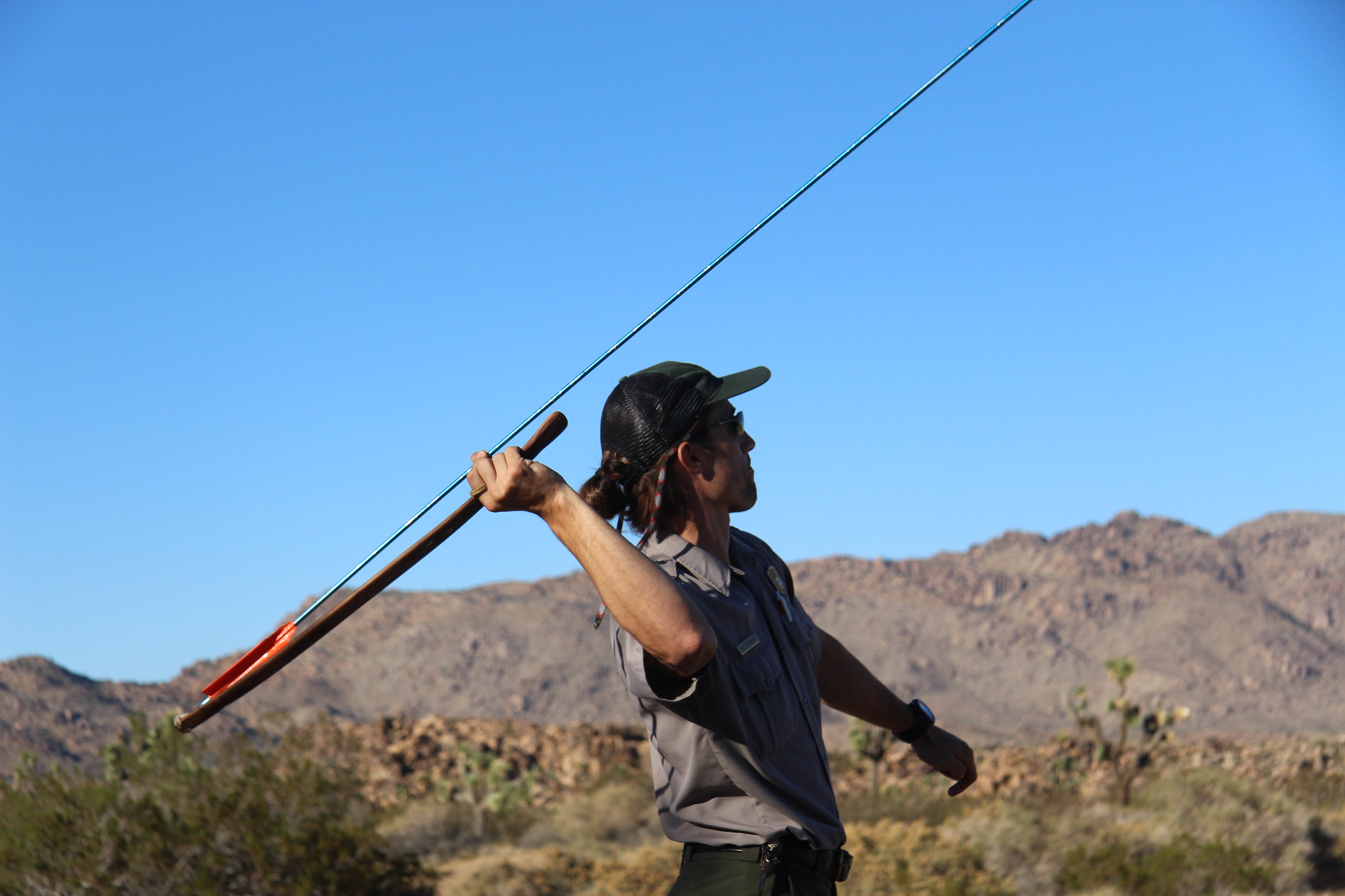I was introduced to these devices about ten years ago by my old camp director, who encouraged the staff to have a distance contest. At maximum range, we were outdistancing 30 lbs draw recurve bows, and the sight of 6′ long darts flying down the field was impressive, to say the least.
Atlatls are simple spear throwing devices, the precursors to the bow and arrow. They consist of a stick about two feet long with a spike on the end, which engages in the slightly hollowed end of the long fletched spear (called a dart) they throw.
Table of Contents
What is an Atlatl?
An ancient ranged weapon predating the bow and arrow, the atlatl is a spear-throwing device thought to have been used in hunting all sorts of now-extinct behemoths, including the Woolly Mammoth.
Atlatls consist of a “dart”, a spear with large fletchings at the rear, launched off a “hammer” stick that extends the leverage of the throwing arm.
A simple atlatl “hammer” can be fashioned from a forked stick, about the diameter of a quarter and two feet long. Lop off one side of the fork and sharpen it down to a point to be fitted into the cup at the back of the dart, and you’re ready to hit the range.
How do you Throw an Atlatl Dart?
Throwing an atlatl dart is a motion very similar to throwing a football, with a wrist flick reminiscent of throwing a Frisbee added to the end.
Handle and grip styles vary wildly on atlatl hammers. Some include a yoke that cradles the dart, while others rely on the user’s fingers to hold the dart in place. Some feature hammer-style grips, while others have rings for the insertion of fingers.
- Once you’ve figured out what kind of handle is on your atlatl (if you just carved a hammer yourself, you’ll be hammer-gripping and finger-cradling), pull one dart out and set it point down on the ground.
- Hook the spur of the hammer into the cup on the fletched end of the dart, and bring the handle of the hammer to the dart.
- Align the shaft of the dart with any yoke your hammer may have, or extend your thumb and forefinger to hold the dart in place.
- Square up side-on to your target, and assume a classic football T-shape: throwing arm cocked back, with the other hand extended out towards your target.
- Involving as much of your body as you can (namely consciously including your back, abs, and legs in the motion) swing your back arm forward, keeping a straight line motion. Drop the front hand out of the way as you go.
- Just before the dart leaves the spur of the hammer, flick your wrist to make a clean detachment and give the dart just a little added oomff!
If that’s clear as mud, or you just want the video version instead, check out this great video on Atlatl Basics with Matt Graham:
How do Atlatls stack up?
As can be reasonably expected, each generation of technological improvement to projectiles has improved in both ease of use and maximum range.
Atlatls rank above the hand-thrown javelins and amentum (javelins thrown with the aid of a short leather strap looped on just behind the center-of-gravity) in terms of ease-of-use and maximum range. Atlatls also allow the user to impart more power to the projectile without as much accuracy penalty as with a javelin.
Formidable weapons though they are, most cultures eventually gave them up in favor of archery. Bows are easier to use accurately, and the massive darts lobbed by the atlatl are unnecessary for the game animals found in much of the world today.
In the table below, I’ve compiled the current world record distance shots (pure max distance, no target) for modern adaptations of javelins, atlatl, longbow, recurve bow, and crossbow.
Drawing on my engineering education, I’ve also back-calculated a lower-bound estimate of the initial velocity each projectile would have needed, assuming a 45 degree launch angle, and neglecting drag.
Actual launch velocities would have been higher, but the differences in scale and speed for the various projectiles prevent any easy way of estimating how much drag would be incurred.
| World Record Distance | Calculated Initial Velocity* | |
|---|---|---|
| Javelin Throw | 344 ft (104.8 m) | 105 fps (32 m/s) |
| Atlatl | 756 ft (230.48 m) | 156 fps (48 m/s) |
| Longbow | 1245 ft (379.51 m) | 200 fps (61 m/s) |
| Recurve Bow | 4009 ft (1222 m) | 359 fps (109 m/s) |
| Crossbow | 6142 ft (1871.84 m) | 445 fps (136 m/s) |
How does it Work?
Atlatls, like slings, are just simple tools used to gain additional leverage on a projectile. The longer reach afforded by the atlatl hammer means the back end of the dart moves through a wider arc when the user’s arm is swung.
So long as the leverage increase is small enough, there isn’t much loss in the speed of the thrower’s arm. Assuming minimal speed loss, the dart moves through 50-75% more distance in the same amount of time with an atlatl, as opposed to hand-throwing a javelin or dart.
This means an atlatl dart can be flung 50% faster than a javelin.
I’m no great javelin thrower, but I also find that aiming with an atlatl is much more intuitive for me than trying to hurl the darts by hand.
If you don’t have an atlatl handy to try it out for yourself, you might be able to construct a throwing arrow to test the same idea.
Sensible Survival has a good post on it with plenty of photos, but the idea is to wrap a string into a notch cut just forward of the fletchings on a conventional arrow, then loop the string down taut to wrap around your hand.
Grip the arrow by the head (field points only please!) and throw it. With a little practice, throwing arrows fly nicely and stick in the target, whereas hand-thrown tend to not even come close.
Atlatls are like throwing arrow strings for full-size javelins
What is an Atlatl Used For?
Atlatls were used for hunting and war, and a few remote indigenous people still use them to hunt for survival.
Nowadays, atlatls are mostly used for recreational purposes in a target field, though a few states in the US have recently opted to allow the use of atlatls for hunting.
Atlatls are fairly widely accepted for use in the taking of rough fish, like carp, but make sure to check your local regulations before giving it a try. The reasoning here appears to be that so long as you skewer the fish with something barbed and reel it in quickly, it won’t suffer too long, and there’s not a great added risk to allowing the use of atlatls in place of bow fishing rigs.
According to Wikipedia, the states that currently allow the use of atlatls for deer hunting (as of this writing in July 2020) includes Pennsylvania, Alabama, Missouri, and Nebraska.
Another resource if you’re interested in state hunting and fishing regulations surrounding the use of an atlatl is this list on Thud’s Cave. It’s a bit dated, but the author of the list wrote the relevant authorities in each of the fifty states to inquire directly about hunting and fishing regulations around the atlatl.
What Next?
If you’re interested in learning more about atlatls, check out the World Atlatl Association for a ton of great resources. Otherwise, you could head on over to my Target Sports category and see if there’s any other articles you’d like to read up on. Watch for new ones soon on fire hardening and straightening shafts soon!
If you’re not in the mood to carve yourself one, or want to just give it a try with a really nice setup, head on over to Thunderbird Atlatl’s storefront on Amazon. They offer a wide range of atlatl styles and different dart sizes, starting at under $100 to get their Nanticoke Atlatl with three darts.


